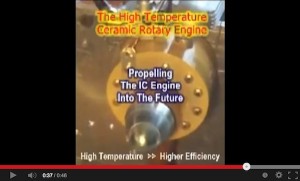
 Screen capture from YouTube video shows CRE’s ceramic rotary engine in action. (Credit: CRE/YouTube.)
Screen capture from YouTube video shows CRE’s ceramic rotary engine in action. (Credit: CRE/YouTube.)
Back in the late 1960s and 1970s, Mazda Motor Corp. made a splash—albeit, not a very big one as far as sheer sales numbers go—with cars and trucks powered by the Wankel rotary engine. Although its simple design had few moving parts and good power-to-weight ratio compared with piston engines, the engine suffered from some problems, chiefly relatively poor fuel mileage and relatively high emissions.
According to its corporate website, which includes an excellent overview of Wankel engine history and technology from Mazda’s perspective, the company sold nearly 2 million vehicles powered by rotary engines before abandoning the design in 1995. But it continued to develop the rotary, incorporating direct fuel injection and other technologies. Mazda launched the RX-8 sports couple in 2002 with a next-generation Wankel engine that addressed some of the earlier models’ shortcomings but still fell short of competitors in terms of fuel mileage. Low sales numbers led the automaker to stop production of the RX-8 in 2012, but Mazda has continued development of rotary engine technology with an eye toward reintroducing it in the next few years.
Mazda has by far the most experience with the Wankel rotary configuration, but it’s not the only company interested in the technology. Ceramic Rotary Engines Inc. has developed a rotary engine design using advanced ceramics for the main components. The company says ceramics allow the engine to run hotter (and thus more efficiently), operate on a variety of fuels, and burn whatever fuel it is using more completely to reduce emissions.
According to CRE’s website, metal engines—whether piston or rotary—suffer from low combustion efficiency that results from their relatively low operating temperatures, substantial heat loss from the high thermal conductivity of metals, and wear that limits the service life of some components. The company says a ceramic engine would minimize all three shortcomings and function as a near-adiabatic system.
After evaluating ceramic materials including silicon nitride, silicon carbide, aluminas, and zirconias, the company chose a ceria-stabilized zirconia for the main components of its rotary engine design based on the material’s high fracture toughness and bend strength, high-temperature capability, low thermal conductivity, and resistance to hydrothermal degradation and oxidation in the presence of a variety of chemically active fuel materials and additives. The material is produced by Ultrahard Materials Ltd., Swansea, UK.
According to CRE, saving the roughly 30% of heat the typical internal combustion engine loses to its surroundings opens up some interesting possibilities for the rotary design. The company proposes use of small Wankel engines—with power in the range of 0.5 kW to 30 kW—for decentralized heating and electrical applications (i.e., as small generators) and even smaller engines producing less than 0.5 kW as replacements for batteries in some applications.
CRE says high operating temperatures would allow engines used in such applications to run on renewable fuels such as cellulosic bioethanol or even straight vegetable oils. It envisions ceramic engines powering water pumps and generating electricity for lighting and cooking in undeveloped regions, reducing the need for firewood.
As for Mazda, it also envisions the Wankel engine as a green technology. Last year, chairman Takashi Yamanouchi said the company’s next-generation rotary engine would be used as a range extender in an electric vehicle, and could even be powered by hydrogen. The unit’s small size and light weight lend themselves to such an application, which would keep the rotor spinning steadily in an optimal rpm range, he said.
CRE has built a working prototype engine. A brief video of the unit is available for viewing on YouTube.
